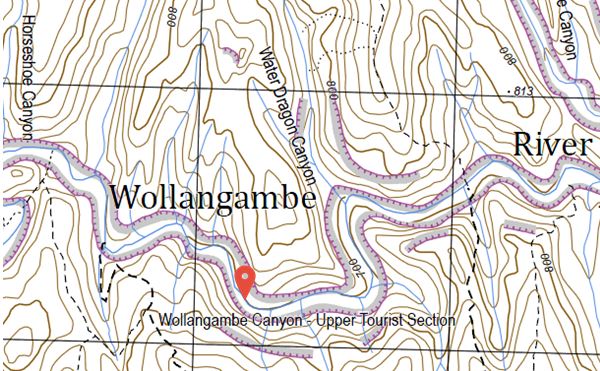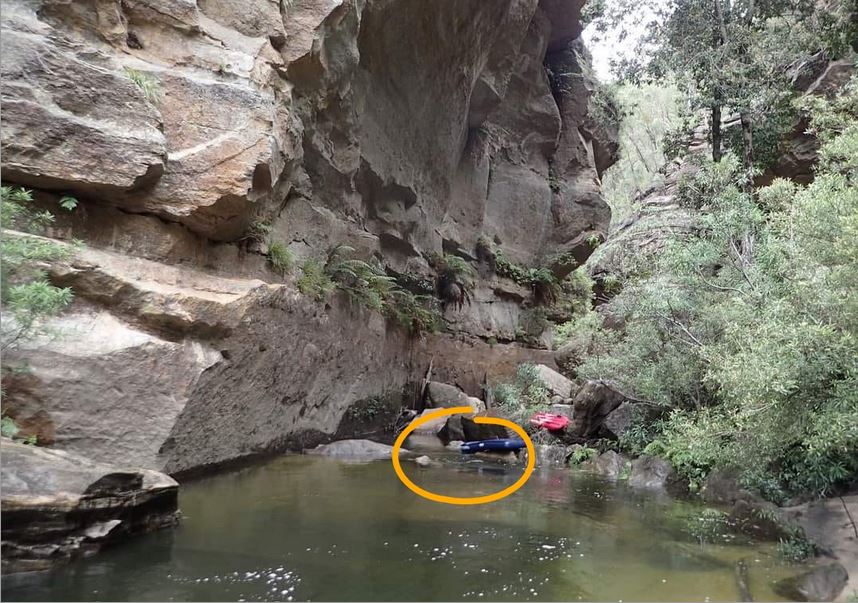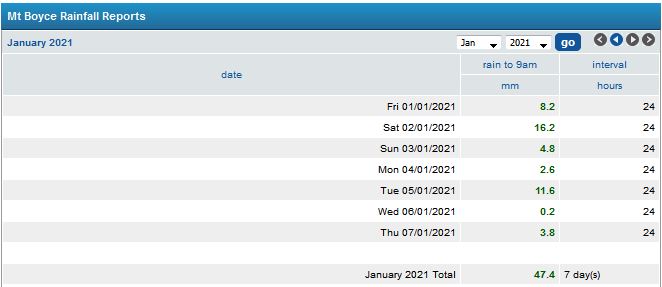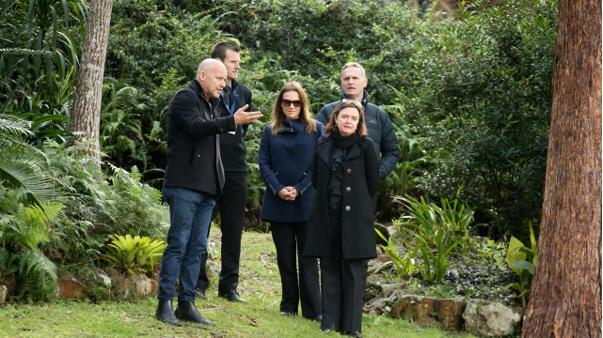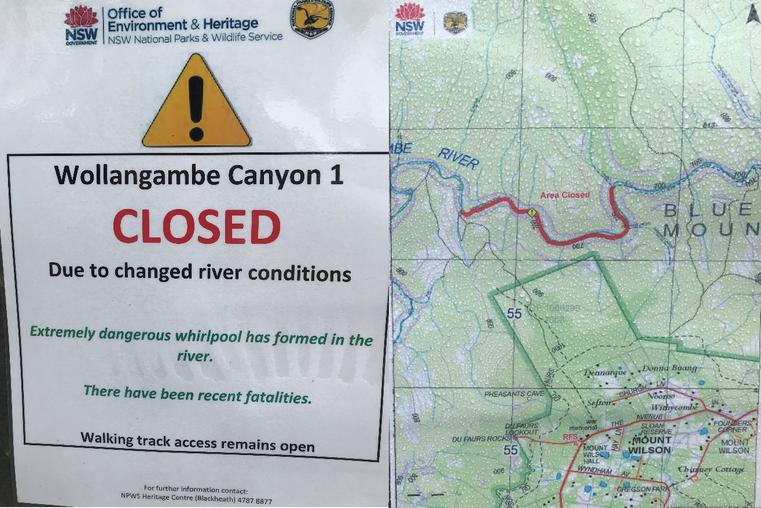Culpably Reckless Canyoning in the Rain

We read sadly that two more visitors to the Blue Mountains partaking on a canyoning trip have just perished. Last Saturday 2nd January 2021 at around 2:30pm, two participants with the locally based Upper Blue Mountains Bushwalking Club have tragically drowned while liloing in Wollangambe Canyon. This increasingly popular wet canyon is situated a few kilometres north of Mount Wilson within the Blue Mountains National Park.
One young woman in the group using a lilo (an inflatable rubber mattress) in a river pool she was in flowed toward a cluster of giant fallen boulders. She was suddenly sucked beneath the surface by a canyon syphon into an underwater tunnel/crevice well below the boulder cluster.
A second woman in the group apparently noticing this incident, quickly and very bravely went to the other woman’s rescue in the pool, but tragically was similarly sucked into the canyon siphon underneath the river level below the boulder cluster. Other participants in the group then threw a rope in a bid to save both, but the two women disappeared below the water and boulders. It was not reported of the actions at the time of the club’s canyoning trip leader.
This is the exact canyon syphon in ‘low water’ conditions.
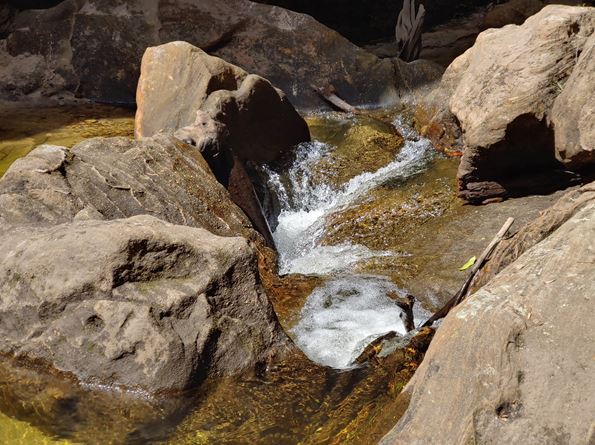 Emergency services rushed to the remote scene after the alarm was raised about 2.30pm, but poor weather conditions meant a search had to be called off at about 6pm.
Emergency services rushed to the remote scene after the alarm was raised about 2.30pm, but poor weather conditions meant a search had to be called off at about 6pm.
‘Weather conditions’ is a broad term. Was it due to rain, the approaching onset of darkness, a combination of both, or else some other weather variant?
Last Light (nightfall) in summer in the Blue Mountains is around 8:30pm after which being pitch black one needs a head torch to walk a metre. Dark rain clouds can make it darker early. Down in canyons, the localised nightfall can place one in pitch blackness 2 hours earlier or more because of the sun shadow effect and dark rain clouds bring forward this timing.
Also, rescuers need to safely allow for a visible climb out from a canyon to the security of their vehicle roadside up on the ridge top. This hike time can be a few hours. So this 6pm cut-off for searching is very fair and safe. In winter with the daylight far less, a 3pm search cut-off would be more like it.
When the police search resumed the following day, the bodies of the two women were located by NSW Police divers. Police Sergeant Atkinson stressed that “canyoning does have risks and canyons’ behaviour is unpredictable.” During the recovery operation, Sgt Atkinson said the behaviour of the water siphon was observed to be changing frequently.
The particular section is known as the Upper Tourist Section and dubbed ‘Wollangambe One‘ and is accessible only by 2km foot track from Mount Wilson. The accident occurred just a kilometre downstream from the track entry point.
Due to ongoing heavy rains the river had more water in it than usual and at the point where the deep river pool flowed to the boulder cluster, a whirlpool or ‘canyon siphon’ had developed sucking the surface river water downwards below the boulder obstacle through a funnel of narrow crevices through rocks and debris. Additional bushfire debris may have been present due to the extensive 2019 bushfires of December 2019 – January 2020, which was followed by torrential East Coast Low rainfall in early February 2020.
Water siphons are a known hazard in wet canyoning.
Canyon siphons are particularly hazardous because they are not always obvious from the water surface. There is no presence of white wild water, but rather just a calm suction downwards and the suction pressure can be considerable.
Inexperienced canyoners would not know about this hazard nor what to look for.
However, in the case of this particular canyon siphon, according to Canyoning Australia’s online forum “other people report seeing this siphon in low water levels as far back as February 2020.”
The location of the siphon where the two women disappeared below the water. The flowing river had to go somewhere…and it was subterranean. To experienced canyoners a prior recce would have detected this hazard. The police divers’ evidence of the recovery operation the following day would surely detail the severity and extent of this siphon.
The first woman was a young Chinese student, Yuanlei Qi 24, one of eight international students on the canyoning trip. The second woman was later identified as Police Senior Constable Kelly Foster, 39, of Lithgow Police Station.
It would appear that both women may have been unqualified and inexperienced in canyoning and that this may have been their first ever canyoning trip. They would have entrusted the Club’s promotion of the trip, the Club’s familiarity with this canyon, and as general members of the public had faith in and to rely upon the expert canyoning skills, knowledge and experience of the club and its delegated trip leader to guide them safely.
However, obviously something went terribly wrong. So was this faith well-founded?
The hydraulic feature involved:
While media reports talked about a “whirlpool”, the technical name for the feature involved is a syphon.
A syphon occurs where the water flows under / through obstacles. In more aquatic canyons, they are considered one of the more dangerous water hazards. Syphons are not always visible and can be fully submerged. Narrow siphons are dangerous because they funnel the water, rapidly increasing its speed. Because Blue Mountains canyons generally have low water flows, we usually see minor features where the water disappears underground, but rarely features capable of causing harm to people.
Some good information about syphons (and other aquatic canyon features) is available here: https://canyonmag.net/technical/safety/ … y/#Siphons
Other people report seeing this syphon in low water levels as far back as February 2020. In those conditions it did not appear concerning, and was simply a hole that the river drained into. The hydrology of this feature may have been altered by the large rain event in February 2020 that followed last summer’s bushfires, bringing large quantities of ash, soil, and debris into the canyon. It may also have been influenced by recent rain.
The following photo shows the syphon in low water. Below that is a video of the same feature, again showing it in low flow.
The families will be awaiting the coroner’s report, yet will this report include evidence from expert witnesses? Not likely.
One known variant on the day and previous days was the advent of heavy rain which had increased the river flow, water volume, height and pressure in Wollangambe River.
The Upper Blue Mountains Bushwalking Club promoted this trip as “a lazy day floating and swimming” on its website, so low risk:
One would question this club’s bushwalking title these days given that it now undertakes not just bushwalking, but also the more adventurous canyoning and abseiling activities. Nature Trail as a commercial operator does not engage in such activities due to the inherent risk, preferring instead to refer such enquiries to commercial Blue Mountains adventure experts.
Our tour director was previously a member of this club up until around 2006 when, while participating on two successive hikes promoted as “easy” and “on walking tracks”; both turned out to be exploratory bush-bash trailblazing through pristine wilderness. As if there aren’t enough tracks carved through remnant ecology as it is. Our tour director resigned in disgust.
Rain on and around 2nd January 2021
The Wollangambe River is believed to have reached heightened levels due to recent heavy rainfall within the catchment
It is of comparative interest to note that on the same Saturday as this club canyoning trip which went ahead, that a hike scheduled by this club on the same day in a nearby area was cancelled due to “weather”. We presume due to rain, but what other reason? Read the club website notice below, misspelling etc:
Rainfall records at the Mount Boyce weather station (situated ~15km SW of Mount Wilson as the crow flies) show the following, including 16mm on the relevant Saturday.
http://www.farmonlineweather.com.au/station.jsp?lt=site&lc=63292&list=rb
It’s been raining almost continually across the Blue Mountains Region since before Christmas 2019. This rain is associated with an East Coast Low system, and in Katoomba there have only been a few days of sunshine since Christmas 2019.
Canyoning Best Practice?
It is widely held good practice in the field of Outdoor Recreation that canyoning is to be avoided during times of rain due the heightened hazard and likelihood of flash flooding causing drowning.
The official position, as outlined in the Canyoning Code of Ethics is:
“Avoid canyoning if rain is forecast or if the weather looks changeable.” Experienced canyoners will generally advise that — unless you are familiar with a particular canyon and know how it responds to wet conditions — you should not go canyoning the day after heavy rain, particularly if more rain is forecast.”
https://canyoning.org.au/forum/viewtopic.php?t=33
The land manager of the Blue Mountains National Park, NPWS (Parks Service) provides safety messages for visitors to this Mount Wilson Area. For what it classifies as ‘adventure sports’ like climbing, caving, canyoning and abseiling, on its website it cautions visitors to be aware of the risks, notably:
“Check the weather forecast before you go. Avoid caving and canyoning after heavy rain or if rain is forecast. Unexpected dangerous conditions arise during elevated water flows after heavy rain.”
“Only participate in activities if you and all members of your group have the right skills and experience. Make sure your leader has enough experience…. Licensed adventure tour operators provide training and instruction, so we always recommend that you head out with a licensed tour operator.”
We note that on the website of the Upper Blue Mountains Bushwalking Club that the Club’s Vice President is also the honourary Canyoning officer. We trust that he is suitably qualified and experienced in leading group canyoning trips, particularly for novices.
However, the media reports that just last September the Club lost another member, Roy Barlow, 65, whom while participating on a club canyoning trip in the Wolgan Valley on 2nd September 2019, fell to his death.
So now there are three deaths within four months from canyoning activities provided by this club. Is a pattern emerging?
The Club warns its members that participation in the activities may expose them to hazards and risks that could lead to injury, illness or death or to loss of or damage to my property. The likely hazards highlighted on its website risks would seem limited to bushwalking, but not those greater hazards particular to abseiling or canyoning. Siphon risks for instance are not mentioned; the closest is “slippery surfaces” and “crossing creeks”.
The Club carries public liability and personal accident insurance for all members through an umbrella policy held by Bushwalking NSW. Well it may be claiming on its insurance soon.
Safety Questions for this ‘Bushwalking’ Club:
- Did the Club’s trip leader on this trip have the requisite skills, qualifications, experience with canyoning?
- How many participants were on this trip and what was their level of canyoning experience?
- How many trip leaders were on this canyoning trip and what level of qualifications and experience did each possess?
- When was the most recent familiarity reconnaissance of this particular canyoning route ‘Wollangambe One undertaken by the trip leader(s)?
- Was any risk assessment undertaken by the trip leader(s)?
- Did the trip leader(s) formally notify the land manager (NPWS at the Blackheath rangers’ office) of the planned club trip to Wollangambe Canyon and if so when?
- Does NPWS Blackheath rangers office have any record of such a club trip notification and of any verbal cautions communicated to the Club’s trip leader? If so, what are the details?
- Did the trip leader(s) previously identify the known siphon ahead of the trip being conducted? Other canyoners had identified the presence of this canyon siphon as far back as February 2019 just after the bushfires, like due to debris entering the river and causing a banking up against the boulders. The river had to flow somewhere and here it was down – under considerable pressure/suction.
- Why did the Club proceed with this canyoning trip despite recent, current, forecast rain?
- Were all the international students participating on this canyoning trip, genuine members of the Club or just guests?
- What swimming skills did each of the trip participants have? Is this documented by the Club?
- What safety briefings were provided by the trip leader)s) to the participants, and when?
- What safety gear was supplied by the trip leader to the participants? Which participants wore a life jacket, and canyoning helmet? Does the Club have any photographic evidence of trip participants wearing life jackets and helmets?
- What was the relative position of the trip leader(s) at the time of the siphon accident – up the front of the group or at the rear?
- What was the relative position to the lilo group were the two female participants – at the time of the siphon accident – up the front of the group or at the rear?
- What was the circumstance of Club member Roy Barlow’s canyoning death?
- What if any membership does the Club and/or its canyoning officer have with the qualified/experienced canyoning fraternity?
A Bushwalking Club?
So is Upper Blue Mountains Bushwalking Club still just a bushwalking club to members if it also provides abseiling and canyoning activities in similar ways that commercial expert operators do?
Or has this club become a defacto canyoning operator without necessitating a commercial canyoning license, nor mandating an Eco-Pass, nor requiring submitted routes to the Parks Service, to just tramp and abseil where it pleases in national parks with impunity?
Just because the club does not charge a commercial fee (presumably), yet provides a similar service to commercial canyoning operators; does this somehow exempt the club from the same duty of care to its members and fast-tracked ‘members’ of the public?
What would such an exemption do to uphold public safety in canyoning?
The Parks Service by turning such a blind eye exemption to clubs to conduct such risky adventure activities with national parks under its jurisdiction, surely has legal accountability and responsibility to protect the public. This may need to be tested in court.
A commercial canyoning operator is presumed to have not just a duty of care to its participating customers in this inherently risky outdoor activity, but because of the operators expertise a high standard of care beyond the legal reasonable person test.
How is this club not culpably reckless given its promoted canyoning services to Club members and to ring in club members like the eight international students, for exposing the participants to significant risk to life in this canyon on this day?
We note that the Upper Blue Mountains Bushwalking Club has ‘deferred” its activities for the next few weeks. This includes its canyoning for obvious reasons. Yet its definition of what it calls “walks” continues to stretch the boundaries as the following examples of deferred trips on the club’s website currently convey:
Sun – 24-Jan-2021
5 H – Canyon
Lower Bell Creek Deferred
Lower Bell Creek is a classic canyon, rated 10/10 by Tom Brennan. There are rope assisted climb downs and long tunnel swims. The canyon formations are amazing. We set up are car shuffle and begin at Watertrough Hill. A pleasant walk across the ridges brings us to Belfry Canyon which leads into Bell Canyon. When we reach Du Faurs Creek we swim upstream to Joes Canyon and climb to the Mt Wilson Fire Station. It is a long demanding day., Bookings open 18 Jan 2021.
Map: Wollangambe
________________________________________
Sat – 23-Jan-2021
5 H – Creek
Odin track via Victoria Brook and Rientz mine Deferred
We’ll walk in via Ridgewell road and visit the mine then make our way down to the junction of Victoria Brook and Victoria Creek. Then walk up
the brook going up the waterfall before exploring the ravines above it. Then an easy exit via the spiked tree and Odin track. A car shuffle will be required and definately wet feet, maybe more.
Map: Mt Wilson
________________________________________
Wed – 20-Jan-2021
5 H – Day Walk
Exploratory bushwalk or non-abseiling canyon Deferred
Depending on the weather, either a walk exploring the amazing country in the Wollemi/Gardens of Stone or a non-abseiling/swimming canyon walk will be offered. Put this date in your diary and watch Short Notice Walk announcements for exact details.
Map: Not Specified
________________________________________
Sun – 17-Jan-2021
3 M – Day Walk
Hassans Walls Explore Deferred
There is lots to explore and we will decide on the area based on the weather/ flora available as some areas are exposed and some sheltered.
Further details to be provided the week before via Google Groups. Not more than 15 km in day and at an easy pace, some scrambling possible
and 200 m ascent/descent. Check out: Painter, K “Hassans Walls Prized and Pillaged” for photos
Map: Lithgow
________________________________________
Sat – 16-Jan-2021
3 MX – Day Walk
Lockleys Pylon, Yardleys cave Deferred
Classic walk from Mt Hay Rd along ridge to Grose Valley.Then along cliff line to Du Faurs Head and around a gully to Yardleys cave. This is an excellent camping cave that overlooks the valley.
Map: Katoomba
________________________________________
Fri – 15-Jan-2021
5 H – Day Walk
Exploratory bushwalk or non-abseiling canyon Deferred
Depending on the weather, either a walk exploring the amazing country in the Wollemi/Gardens of Stone or a non-abseiling/swimming canyon walk will be offered. Put this date in your diary and watch Short Notice Walk announcements for exact details.
Map: Not Specified
________________________________________
Mon – 11-Jan-2021
3 MX – Day Walk
A section of Bruces Walk at North Katoomba Deferred
From Minnehaha Reserve, a track will be followed to intersect Bruces Walk at the top of a ridge, than follow Bruces Walk down and up
Katoomba Creek to Medlow Bath Trig Station at Katoomba Airfield. A car shuffle will occur.
Map: Katoomba
________________________________________
Sat – 09-Jan-2021
5 H – Day Walk
Newnes State Forest and Blue Mountains National Park: Cerberus Canyon, Cerberus Falls and Hair of the Dog Ravine Deferred
Half of this walk is in an unprotected area of Newnes SF; the other half is in the Blue ountains NP. The straight boundary line, drawn by politicians, makes no sense when it comes to natural beauty. See it for yourself! Park the vehicles at the locked gate at the end of Waratah Ridge Road. Walk into and down the Hair of the Dog Ravine at GR 493 038. After exiting the ravine, make our way west to Cerberus Creek and its canyon. Go through the canyon, visiting Cerberus Falls and exit at about GR 472 038. Walk on the road back to the cars. About 10k.
Map: Wollangambe
________________________________________
Sat – 09-Jan-2021
4 MHX – Creek
Upper Bell Creek Deferred
Beautiful Creek, deep pools canyon cliffs and yabbies’ a lot of swims so wet suit essential as water is cold
Map: Mt Wilson
________________________________________
Thu – 07-Jan-2021
4 MH – Canyon
Galah Canyon Deferred
Galah canyon is a great canyon in the lower reaches of Rocky Creek, Newnes Plateau. It has about 7 or so abseils up to 35m and a magnificent cathedral-like chamber at the end. There is some wading involved so a wetsuit is optional, and there is a bit of a scramble at the exit (with a rope for assistance). It is a longish day with about 12km walk. It may be lightly raining according to the current weather report.
Map: Rock Hill
https://www.ubmbc.org.au/activities/act-program.html
Lack of Uniform Canyon Risk Grading
We also note that Australia lacks a canyon risk grading system used in countries like New Zealand, American and France. The risk grading factors in the vertical difficulty, the water difficulty (which varies with rainfall and flooding intensity), the canyon’s length and so the extent of ‘commitment by the canyoner, and an optional star rating for aesthetics.
Does any such canyon risk grading exist in Australia? If so does it get applied? Did the Upper Blue Mountains Bushwalking Club (a misnomer) apply any such canyon risk grading on the day?
Local Blue Mountains media report that witnesses to the canyon siphon on the Saturday was “a 3 to 4 metres deep”. Under the New Zealand canyon grading system, which adopts the French grading system, it is probably that Wollangambe One Canyon on Saturday 2 January 2021 as: v2a7III*.
Check for yourself:
 Loading...
Loading...
A trip for beginners should therefore have been cancelled due to weather, just like the Club did the same day with its schedule hike nearby.
Are Club bushwalkers pushing the limits of bush-bashing to include canyoning without proper training by qualified and experienced experts?
Postscript:
[Dated 3rd Nov 2022]
Closure is so easy by a strike of a pen by some coroner, but for loved ones there is never closure to a tragic death in a family – for two families in this case.
Lessons Learned?
- None it seems.
- Snr Constable Foster’s family requested an inquest, but the deputy coroner has denied the family their right. Why?
- The NSW Deputy Coroner, presumably having actual read the case facts, has decided that a member of the public who casually signs up as a member to partake with a bushwalking club to “come and join us on a lazy day floating down” some river, and should drown is legally deemed “accidental drowning” by “misadventure, canyoning”. This was the Upper Blue Mountains Bushwalking Club very promo:
- Deputy Coroner: “The circumstances are not suspicious according to police” (so not deemed a criminal negligence, despite the presence of a deadly syphon?)
- Manslaughter by criminal negligence arises when the accused does an act “consciously and voluntarily without any intention of causing death or grievous bodily harm but in circumstances which involved such a great falling short of the standard of care which a reasonable man would have exercised and which involved such a high risk that death or grievous bodily harm would follow that the doing of the act merited criminal punishment”: Nydam v The Queen [1977] VR 430 at 445, approved in The Queen v Lavender (2005) 222 CLR 67 at [136].
- Deputy Coroner: This court is “aware of changes made by the National Parks and Wildlife Service and the Upper Blue Mountains Bushwalking Club (UBMWC) following these tragic deaths“. What changes?
- Some anonymous contributor ‘T2’ to Canyoning Australia’s forum reckoned on 3rd January 2021 (the day following the reported deaths), commented:
- “Yes, an extremely tragic outcome. There are lots of questions that many people have about this accident, but I think it’s best to let the dust settle before speculating. The facts, as we know them, are that this was a trip run by a reputable bushwalking club. It was led by a very experienced leader. It was a simple lilo trip down Wollangambe One. Knowing the club involved, I am sure they will provide further details when the time is right. I imagine the leader, and the rest of the group, are still in shock. This would have been an incredibly traumatic experience for all of them, and we need to give them time to heal and process what has happened before pushing for more information.”
- Well T2, the dust has well settled dude. The authorities are writing this one off. Are you still pushing for more information?
- Parks Service (NPWS of NSW) claimed it had previously conducted…
“a formal risk assessment and sought independent, expert advice. They brought in giant boulders by helicopter to ensure the large underground chamber where the women became trapped could be filled. They have monitored the new hydraulic feature through rain events.”
- So publicly disclose those records Parks Service, if they exist?
- Instructions for the canyon on the Parks Service website reckon you must be a good swimmer to do it and warn about “dangerous whirlpools”. It also recommends avoiding the canyon “just before, during or after heavy rainfall”. The club did neither, obviously.
- No reconnoitre was undertaken by the club’s trip leader, so the syphon was unknown on the trip.
- The bushwalking club’s new president Jim O’Keeffe has since declared to the media since the two deaths:
“a new role for a canyoning coordinator who oversees the canyon program, as well as a grading system for canyons and a guidelines for canyoning “leaders.“
That is, forget it and move on. She’ll be right Jimbo!
May be the bushwalking club ought stick to bushwalking. Public beware of cheap $20 sign up trips with bushwalking clubs offering cheap non-bushwalking trips. You pay for what you get. A last minute $20 membership sign up gets death.
A commercial hiking tour operator is presumed to not only have an implied duty of care at its customers, but as a professional to have a higher standard of care than a reasonable person such as unpaid voluntary bushwalking club trip leader.
A $300 full-day professional hiking tour does not do lilos down wet canyons in the first place, and everyone returns safely home from every trip delivered.
Further Reading:
[1] ‘Criminal Negligence‘, in the Sentencing Bench Book, Judicial Commission of New South Wales, (a NSW Government department) , ^https://www.judcom.nsw.gov.au/publications/benchbks/sentencing/manslaughter.html#:~:text=Manslaughter%20by%20criminal%20negligence%20arises,and%20which%20involved%20such%20a

